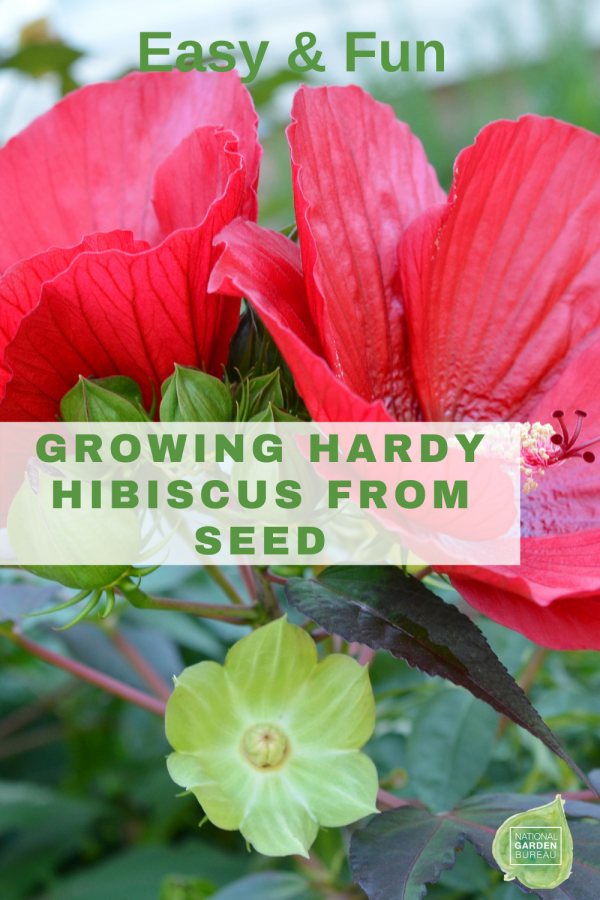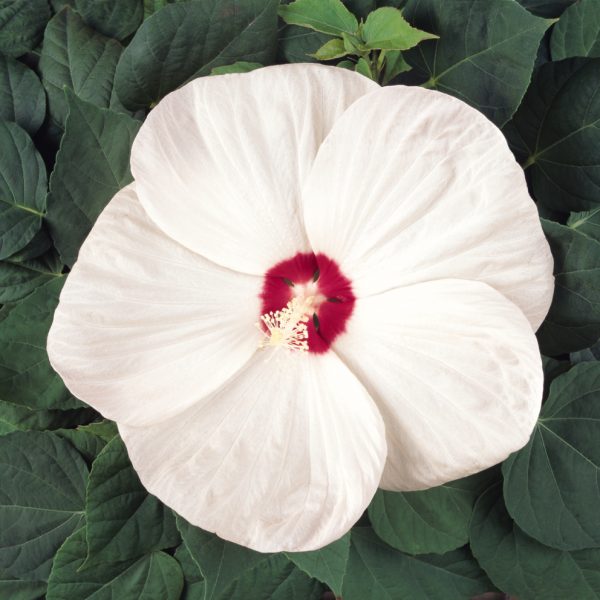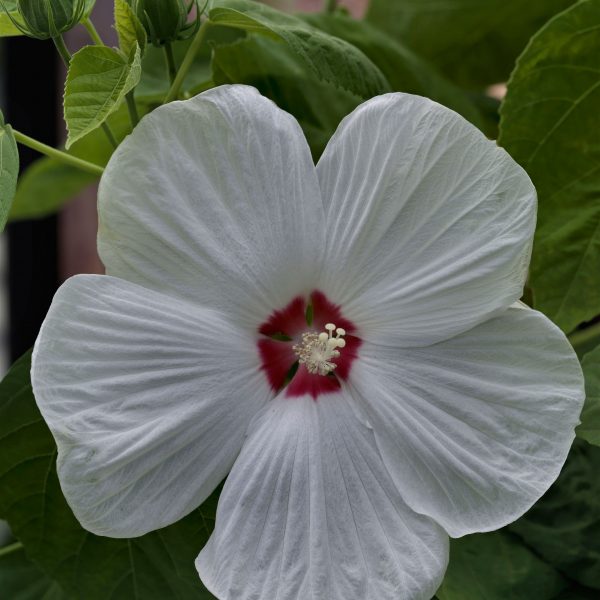Originally appeared at National Gardening Bureau
Yes, You Can Grow Hardy Hibiscus from Seed!
When it comes to adding drama and flair to the garden, you don’t need to look any further than this year’s featured flowering shrub; our very own, native Hardy Hibiscus. Hardy Hibiscus are deciduous shrubs, perennial in zones 4-9 and are comprised of the species moscheutos and of cultivars of the species syriacus. H. moscheutos is native to the wetlands of North America, thriving in marshes and floodplains of the Mid-West and Northeastern US all the way down to the coastal lands and swamps of Florida and Texas.
Often referred to as Rose Mallow or Swamp Mallow, H. moscheutos is a statuesque shrub, with multiple stems born of a single crown. In natural settings, it reaches 3-7 feet in height and 2-4 feet in width. H. moscheutos is apical dominant with rounded open branching and pleasing architecture. The ovate or heart-shaped leaves are alternate, lanceolate, and have toothed edges. The leaves are dark green on the top with a pubescent white underside. The large dark leaf provides a perfect backdrop for massive, bold flowers. The dinnerplate-sized blooms can reach 8-10 inches in diameter. They are composed of 5 overlapping petals, and as with all flowers of the Malvaceae family, a fused columnar stamen, white to light yellow in color. Flower petals range from white, pink, swirled rose bicolor, to deep red, often with a highly contrasting eye. Flowers are fleeting, only open for 1-2 days, but the profusion of showy blooms continues throughout its long season of mid-summer to fall. In-ground shrubs can have as many as 20 blooms per day.
Being an herbaceous perennial in many growing regions, the plant dies back to its crown in the fall, remaining dormant through the winter. With a bit of pruning and a few inches of mulch to protect the crown, it will return with a flowery vengeance the following season, ready to put on a show bushier and more prolific than the last.
New Breeding
Hardy hibiscus has been commercially hybridized from the start of the 20th century but has enjoyed the greatest progress from the 50’s onward. One of the most daring objectives can be appreciated in the improved compact habit, which brought the naturally tall and rangy stature down into a much more manageable form, thus allowing for expanded applications and greater consumer enjoyment. (Check plant tags for exact plant height.) Increased flower size, expanded range of flower and leaf color, and increased cold tolerance have also been high priorities, often achieved by reaching into adjacent species to pull in wanted traits.
‘Mallow Marvels’ were some of the founding genetics from which breeders such as Flemings Flower Fields, used to create the earliest and best-known cultivars such as, ‘Kopper Kings’ and ‘Southern Belles.’ These in turn helped to bring forth current favorites such as ‘Lord Baltimore’, ‘Mars Madness’, the ‘Summer Spice’ series, and SUMMERIFIC®. Cutting varieties bring exciting colors and flower forms to the garden.
Luna™ Series
A popular variety bred by NGB member PanAmerican Seed.
Disco Belle™ Series
A popular variety bred by NGB member Sakata Seed.
Starting Your Hardy Hibiscus from Seed
Starting seed varieties at home is easy and fun and also an economical way to enjoy the plant from beginning to end.
- Sow seed indoors 6-12 weeks before the last frost depending on your zone.
- Seeds soaked overnight help jumpstart the process.
- Sow the large seed ½ inch deep into well-draining soil and keep at 60% humidity in full sun or under lamps.
- After 4-5 weeks, transplant into larger pots, taking care not to disrupt the taproot.
- As the last frost approaches in the spring, harden off the transplants during the day to achieve a stronger and more weather-resistant plant.
- Better branching and thus more flowers can be achieved by pinching back the tips when the young plant is around 6-8 inches in height.
Where to Plant Your Hardy Hibiscus
In the Northern areas, hibiscus works best in full sun and will thrive in South facing plantings. In the hot Southern regions, you may want to give it a little reprieve with partial shade. Hibiscus excels in high heat and humidity. A balance of light, good air circulation, and protection from harsh winds will keep diseases and structural damage at bay.
Hibiscus enjoys well-hydrated, slightly acidic soil with lots of organic matter. It prefers nutrient-rich soil, and adequate potassium is a must for ultimate flowering. If you have sandy or poor soil, you will want to amend, working in some organic matter to hold in the nutrients and moisture. A well-balanced slow release fertilizer applied twice a year usually does the trick, but this is of course dependent on your initial soil quality.
How to Use
Hibiscus can add a tropical flair to planters, be featured as a showy garden specimen or contribute height and drama to garden beds. It’s a great accent choice for low-lying landscapes with water features since it is native to wetlands. It’s also a fantastic addition to pollinator gardens, as it is an effective attractor of butterflies, bees, and hummingbirds- with the added benefit of being deer resistant. Thanks not only to the inherent qualities of this North American native but also to breeders and horticulturists throughout the decades, Hardy Hibiscus offers many avenues of use and enjoyment in our modern-day gardens.







